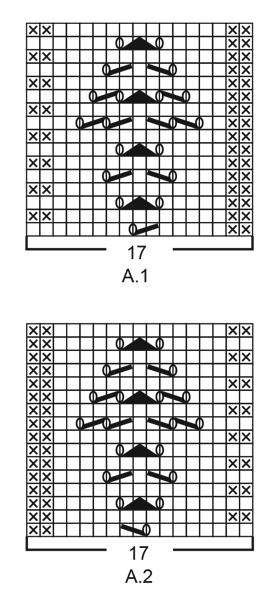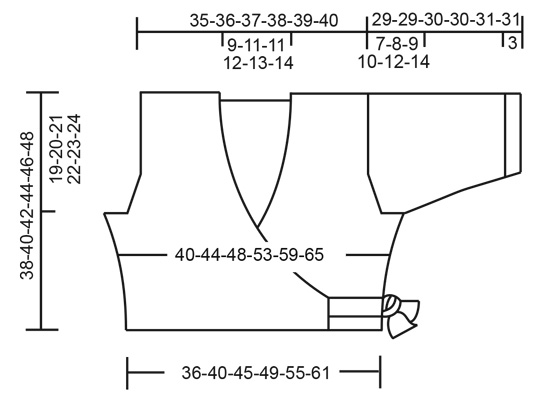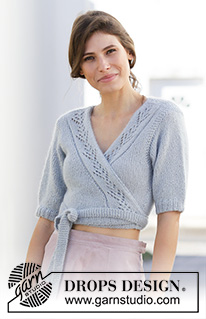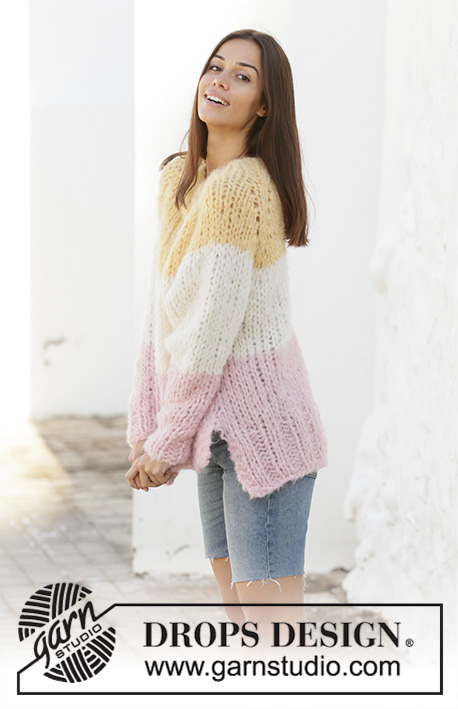Holiday in Rome |
|||||||||||||||||||
 |
 |
||||||||||||||||||
Knitted wrap-around jacket in DROPS Alpaca and DROPS Kid-Silk. Piece is knitted top down with lace pattern. Size: S - XXXL
DROPS 199-48 |
|||||||||||||||||||
|
EXPLANATION FOR THE PATTERN: ---------------------------------------------------------- GARTER STITCH (back and forth): Knit all rows. 1 ridge vertically = knit 2 rows. PATTERN: See diagrams A.1 and A.2. Diagrams show all rows in pattern seen from the right side. INCREASE TIP-1 (applies to armholes): All increases are done from the right side. Increase inside 3 edge stitches in garter stitch. Increase 1 stitch by making 1 yarn over. On next row (wrong side) purl yarn over twisted to avoid holes. Then work the increased stitches in stockinette stitch. INCREASE TIP-2 (applies to neckline at the front): Increase for neck inside 17 stitches in A.1/A.2. Increase 1 stitch by making 1 yarn over. On next row (wrong side) purl yarn over twisted to avoid holes. Then work the increased stitches in stockinette stitch. DECREASE TIP-1 (applies to sides of body): All decreases are done from the right side! Decrease inside 1 edge stitch in garter stitch. Decrease as follows after 1 edge stitch in garter stitch: Slip 1 stitch knitwise, knit 1, pass slipped stitch over stitch worked. Decrease as follows before 1 edge stitch in garter stitch: Work until 2 stitches remain before edge stitch, knit 2 together. DECREASE TIP-2 (applies to mid under sleeves): Work until 3 stitches remain before marker thread, knit 2 together, knit 2 stitches (marker thread is between these 2 stitches), slip 1 stitch knitwise, knit 1, pass slipped stitch over stitch worked (= 2 stitches decreased). ---------------------------------------------------------- START THE PIECE HERE: ---------------------------------------------------------- WRAP-AOURND JACKET - SHORT OVERVIEW OF THE PIECE: Front pieces and back piece are worked back and forth on circular needle, top down. Then pick up stitches for ties. Sleeve cap is worked back and forth on circular needle, top down. Then work the rest of sleeve in the round on circular needle/double pointed needles top down. RIGHT SHOULDER BACK (when garment is worn): Cast on 22-22-22-22-22-22 stitches on circular needle size 4 mm = US 6 with 1 strand Alpaca + 1 strand Kid-Silk (= 2 strands). Work 1 ridge in GARTER STITCH - read explanation above. Switch to circular needle size 5 mm = US 8, and continue with garter stitch until piece measures approx. 2 cm = ¾", on last row from wrong side cast on 16-18-18-20-22-24 new stitches on needle = 38-40-40-42-44-46 stitches. Put piece aside and work the left shoulder at the back. LEFT SHOULDER BACK (when garment is worn): Cast on 22-22-22-22-22-22 stitches on circular needle size 4 mm = US 6 with 1 strand Alpaca + 1 strand Kid-Silk (= 2 strands). Work 1 ridge in GARTER STITCH - read explanation above. Switch to circular needle size 5 mm = US 8, and continue with garter stitch until piece measures approx. 2 cm = ¾", adjust so that last row is worked from wrong side. Now work parts together and work back piece as explained below. BACK PIECE: Slip right shoulder and left shoulder on to same circular needle size 5 mm = US 8 = 60-62-62-64-66-68 stitches. Begin from right side and work 3 ridges in garter stitch over all stitches. Then work in stockinette stitch with 3 edge stitches in garter stitch in each side towards armholes. When piece measures 17-14-8-11-9-7 cm = 6¾"-5½"-3⅛"-4⅜"-3½"-2¾", increase 1 stitch in each side for armholes – read INCREASE TIP-1. Increase like this every 4th-4th-4th-2nd-2nd-2nd row, 2-4-8-11-15-19 times in total in each side. Continue to work until piece measures 19-20-21-22-23-24 cm = 7½"-8"-8¼"-8¾"-9"-9½". Now cast on 3 new stitches for armholes at the end of the next 2 rows = 70-76-84-92-102-112 stitches. Work 4 rows in stockinette stitch with 6 stitches in garter stitch in each side. Then work in stockinette stitch with 1 edge stitch in garter stitch in each side. When piece measures 4 cm = 1½" from armhole, decrease 1 stitch in each side - read DECREASE TIP-1 (= 2 stitches decreased). Repeat decrease when piece measures 8 and 12 cm = 3⅛" and 4¾" = 64-70-78-86-96-106 stitches. Work until piece measures 16-17-18-19-20-21 cm = 6¼"-6¾"-7"-7½"-8"-8¼" from armhole, at the same time, on last row from wrong side adjust number of stitches to 64-70-79-85-97-106 stitches (back piece measures now approx. 35-37-39-41-43-45 cm = 13¾"-14½"-15¼"-16⅛"-17"-17¾" from shoulder). Switch to circular needle size 4 mm = US 6 and work next row from right side as follows: 1 edge stitch in garter stitch, * purl 2, knit 1 *, repeat from *-* until 3 stitches remain on needle, purl 2 and finish with 1 edge stitch in garter stitch. Continue rib like this for 3 cm = 1⅛". Loosely bind off stitches with knit over knit and purl over purl. Back piece measures approx. 38-40-42-44-46-48 cm = 15"-15¾"-16½"-17¼"-18"-19" from shoulder. RIGHT FRONT PIECE (when garment is worn): Cast on 22-22-22-22-22-22 stitches on circular needle size 4 mm = US 6 with 1 strand Alpaca + 1 strand Kid-Silk (= 2 strands). Work 1 ridge. Switch to circular needle size 5 mm = US 8 and work next row from right side as follows: 3 edge stitches in garter stitch towards armhole, 2-2-2-2-2-2-2 stitches in stockinette stitch, A.1 (= 17 stitches). Continue pattern back and forth like this. When piece measures 4 cm = 1½", increase for neck line inside A.1 towards mid front - read INCREASE TIP-2. Increase like this every 4th row (i.e. every other row from right side) 8-8-9-11-12-13 times in total and then every other row (i.e. every row from right side) 17-18-17-16-16-16 times in total. At the same time when piece measures 17-14-8-11-9-7 cm = 6¾"-5½"-3⅛"-4⅜"-3½"-2¾", increase 1 stitch in the side for armhole - continue to increase the same way as on back piece. Work until piece measures 19-20-21-22-23-24 cm = 7½"-8"-8¼"-8¾"-9"-9½", and cast on 3 new stitches at the end of next row from wrong side. Continue as before with A.1 towards mid front, increase for neck line and stockinette stitch but over the outermost 6 stitches towards the side work 2 ridges (i.e. this is done on the next 4 rows). Then work in stockinette stitch with 1 edge stitch in garter stitch towards the side, and A.1 towards mid front (continue increase as before). When piece measures 4 cm = 1½" from armhole, decrease 1 stitch in the side - read DECREASE TIP-1. Repeat decrease when piece measures 8-8-9-9-10-10 and 12-13-14-15-16-17 cm = 3⅛"-3⅛"-3½"-3½"-4"-4" and 4¾"-5⅛"-5½"-6"-6¼"-6¾". After all increases and decreases, there are 49-52-56-60-65-70 stitches on needle. Work until piece measures 16-17-18-19-20-21 cm = 6¼"-6¾"-7"-7½"-8"-8¼" from armhole and at the same time, on last row from wrong side, adjust number of stitches to 49-52-58-61-64-70 stitches (35-37-39-41-43-45 cm = 13¾"-14½"-15¼"-16⅛"-17"-17¾" from shoulder). Switch to circular needle size 4 mm and work next row from right side as follows: 1 edge stitch in garter stitch, * knit 1, purl 2 *, repeat from *-* until 3 stitches remain on needle (towards mid front), knit 1 and finish with 2 edge stitches in garter stitch. Continue rib like this for 3 cm = 1⅛" - NOTE: Rib should fit nicely over A.1. Loosely bind off stitches with knit over knit and purl over purl. Front piece measures approx. 38-40-42-44-46-48 cm = 15"-15¾"-16½"-17¼"-18"-19" from shoulder. LEFT FRONT PIECE (when garment is worn): Cast on 22-22-22-22-22-22 stitches on circular needle size 4 mm = US 6 with 1 strand Alpaca + 1 strand Kid-Silk (= 2 strands). Work 1 ridge. Switch to circular needle size 5 mm = US 8 and work next row from right side as follows: Work A.2 (= 17 stitches), work 2 stitches in stockinette stitch and finish with 3 edge stitches in garter stitch towards armhole. Continue pattern back and forth like this. When piece measures 4 cm = 1½", increase for neck line inside A.2 towards mid front - read INCREASE TIP-2. Increase like this every 4th row (i.e. every other row from right side) 8-8-9-11-12-13 times in total and then every other row (i.e. every row from right side) 17-18-17-16-16-16 times in total. At the same time when piece measures 17-14-8-11-9-7 cm = 6¾"-5½"-3⅛"-4⅜"-3½"-2¾", increase 1 stitch in the side for armhole - continue to increase the same way as on back piece and right front piece. Work until piece measures 19-20-21-22-23-24 cm = 7½"-8"-8¼"-9¾"-9"-9½", and cast on 3 new stitches at the end of next row from right side. Continue as before with A.2 towards mid front, increase for neck line and stockinette stitch but over the outermost 6 stitches towards the side work 2 ridges (i.e. this is done on the next 4 rows). Then work in stockinette stitch with 1 edge stitch in garter stitch towards the side, and A.2 towards mid front (continue increase as before). When piece measures 4 cm = 1½" from armhole, decrease 1 stitch in the side - read DECREASE TIP-1. Repeat decrease when piece measures 8-8-9-9-10-10 and 12-13-14-15-16-17 cm = 3⅛"-3⅛"-3½"-3½"-4"-4" and 4¾"-5⅛"-5½"-6"-6¼"-6¾". After all increases and decreases, there are 49-52-56-60-65-70 stitches on needle. Work until piece measures 16-17-18-19-20-21 cm = 6¼"-6¾"-7"-7½"-8"-8¼" from armhole and at the same time, on last row from wrong side, adjust number of stitches to 49-52-58-61-64-70 stitches (35-37-39-41-43-45 cm = 13¾"-14½"-15¼"-16⅛"-17"-17¾" from shoulder). Switch to circular needle size 4 mm and work next row from right side as follows: 2 edge stitches in garter stitch towards mid front, * knit 1, purl 2 *, repeat from *-* until 2 stitches remain on needle, knit 1 and finish with 1 edge stitch in garter stitch towards the side. Continue rib like this for 3 cm = 1⅛" - NOTE: Rib should fit nicely over A.2. Loosely bind off stitches with knit over knit and purl over purl. Front piece measures approx. 38-40-42-44-46-48 cm = 15"-15¾"-16½"-17¼"-18"-19" from shoulder. SLEEVE: Cast on 22-24-26-28-24-26 stitches on circular needle size 5 mm = US 8 with 1 strand Alpaca + 1 strand Kid-Silk. Work stockinette stitch back and forth to sleeve cap, and cast at the same time on new stitches at the end of every row in each side as follows: Cast on 3 stitches 1 time in each side, 2 stitches 3-3-3-3-4-4 times in each side, 1 stitch 0-1-2-3-3-5 times in each side, 2 stitches 3-3-3-3-4-4 times in each side, and then 3 stitches 1 time in each side = 58-62-66-70-74-80 stitches. Put piece together and continue in the round on double pointed needles/a short circular needle. Insert 1 marker thread where piece is put together = mid under sleeve. Use marker thread later when decreasing mid under sleeve. Work in stockinette stitch in the round. When piece measures 4 cm = 1½" from where it was put together, decrease 2 stitches mid under sleeve - read DECREASE TIP-2. Decrease like this every 4-3-2-1½-1-1 cm = 1½"-1⅛"-¾"-½"-⅜"-⅜" 3-4-5-6-7-9 times in total = 52-54-56-58-60-62 stitches. Work until piece measures 19-18-18-17-16-14 cm = 7½"-7"-7"-6¾"-6¼"-5½" from where piece was put together. Switch to double pointed needles size 4 mm = US 6 and work rib in the round (knit 1/purl 2) for 3 cm = 1⅛", at the same time adjust number of stitches to 54-54-57-57-60-63 on first round. Loosely bind off stitches with knit over knit and purl over purl. Sleeve measures approx. 29-29-30-30-31-31 cm = 11⅜"-11⅜"-11¾"-11¾"-12¼"-12¼" from cast-on edge and down. Work another sleeve the same way. ASSEMBLY: Sew shoulder seams inside cast-off edge. Sew side seam inside 1 edge stitch but leave an opening in each side to thread the ties through - place opening just above the rib in each side, and 2½–3 cm = 1"-1⅛" up towards armholes. Insert sleeves inside edge in garter stitch along armholes and fasten neatly from right side (the edge should not be loose when sewing: sew in the outermost stitch in garter stitch from right side, so that the edge in garter stitch lies nicely on top of sleeve). TIE RIBBON: Pick up on needle size 4 mm = US 6 with 1 strand of each quality: Approx. 6-7 stitches along rib edge at the front. Work in garter stitch back and forth until tie measures approx. 75-100 cm = 29½"-39⅜", bind off. Knit another tie on the other front piece. |
|||||||||||||||||||
Diagram explanations |
|||||||||||||||||||
|
|||||||||||||||||||

|
|||||||||||||||||||

|
|||||||||||||||||||
|
Have you made this or any other of our designs? Tag your pictures in social media with #dropsdesign so we can see them! Do you need help with this pattern?You'll find tutorial videos, a Comments/Questions area and more by visiting the pattern on garnstudio.com. © 1982-2024 DROPS Design A/S. We reserve all rights. This document, including all its sub-sections, has copyrights. Read more about what you can do with our patterns at the bottom of each pattern on our site. |
|||||||||||||||||||





































































Comments / Questions (28)
Bonjour, Est-il possible de faire le dos et les devants plus longs que spécifié ? Une fois les dernières diminutions faites, peut-on continuer tout droit ou doit-on faire d'autres diminutions si on veut rallonger le dos et les devants ?
04.04.2021 - 22:50DROPS Design answered:
Bonjour Mme Grekov, fort probablement, vous pouvez même augmenter sur les côtés pour un effet cintré. Inspirez-vous d'un modèle de la longueur souhaitée dans la même tension si besoin. Bon tricot!
06.04.2021 - 14:07Hi there! I can’t find any information for how many balls of yarns I would need for this. How many balls of the Drops Alpaca and Drops Kid Silk would I need for a size small? Thanks
25.03.2021 - 18:28DROPS Design answered:
Dear Mrs Burston, you will find the total weight of each yarn required for each size under the header; ie in S you will need 200 g DROPS Alpaca/50 g a bal = 4 balls Alpaca + 75 g DROPS Kid-Silk/25 g a ball = 4 balls Kid-Silk. Happy knitting!
26.03.2021 - 07:08Hi, I just wanted to ask you to clarify the bit where it says, "Slip right shoulder and left shoulder on to same circular needle size 5 mm = 60-62-62-64-66-68 stitches. Begin from right side and work 3 ridges in garter stitch over all stitches." Does this mean the two shoulder back pieces are together because on the pictures it looks like there are apart. Thank you.
19.01.2021 - 22:19DROPS Design answered:
Dear Catherine, you first work 2 cm on each shoulder casting on new stitches for neck at the end of right shoulder, then, after left shoulder has been worked you work from right side: the 22 stitches on left shoulder, the 16 to 24 new stitches cast on at the end of right shoulder for neck ending with the 22 stitches for left shoudler = you should have now 60 to 68 sts on needle. Happy knitting!
20.01.2021 - 07:42In the right front piece it says "increase 1 stitch in the side for armhole - continue to increase the same way as on back piece" does this mean to increase every 4th row 8 times and then every other row or just every other row?
09.07.2020 - 18:06DROPS Design answered:
Dear Briana, in the 3rd size you will increase for armhole 1 stitch towards armhole (1 st increased on front piece) 8 times in total every 4th row than cast on 3 sts at the end of next row towards armhole. Happy knitting!
10.07.2020 - 07:47Would you please explain where i do increases for the right front piece ( when garment is worn) it says "When piece measures 4 cm = 1 1/2”, increase for neck line inside A.1 towards mid front - so where are the increases done? Does it mean the increases are just before the lace pattern? I have been increasing after the first 5 stitches (3 garter, 2 stocking st.)
19.03.2020 - 15:29DROPS Design answered:
Dear Mrs Jonas, when piece measures 4 cm you will increase on right front piece 1 stitch before A.1 (as explained under INCREASE-TIP 2, ie work RS row until 17 stitches remain (= A.1) make 1 yarn over and work the 17 sts in A.1 as before. And continue increasing like this, ie always just before A.1. Happy knitting!
19.03.2020 - 15:55Jeg har nu strikket bagstykket og skal i gang med højre forstykke. Jeg kan ikke forstå at der står at jeg skal strikke 3 masker retstrik, 2 m glatstrik og så mønster. Skal man ikke se blusen som om man selv har den på og så man kigger ned på den ? Eller er "højre" set fra én der kigger hen på blusen ? Jeg kan slet ikke få det til at give mening. Den rille der er mellem glatstrik og mønster er det retstrik eller er det vrangmasker eller noget ?
03.02.2020 - 21:40DROPS Design answered:
Hej Christina, vi beskriver stykkerne som når man selv har tøjet på :)
11.02.2020 - 10:36Bjr, je commence le dos et suis étonnée de commencer les emmanchures qu'à 7 cm... Peut-être dois-je commencer les augmentations à 7 cm à partir des 3 rangs de côtes mousse ? Cela me paraît un peu trop tôt.... J'ai du mal à projeter le dos ... Merci de votre aide. Cordialement
11.08.2019 - 00:04DROPS Design answered:
Bonjour Corinne, mesurez à partir du rang de montage de l'une des 2 épaules, et commencez les augmentations à 7 cm, puis vous allez les répéter 19 fois au total tous les 2 rangs et vous monterez ensuite 3 m de chaque côté pour les emmanchures. Bon tricot!
12.08.2019 - 07:57Hallo, ich habe mir das Modell gerade eben nochmal angeschaut... . Bin jetzt selbst drauf gekommen, dass die Zunahmen vor / bzw. nach dem Lochmuster gemacht werden müssen... . Dann sollte es stimmen !
01.08.2019 - 11:49Hallo, eine sehr schöne Jacke... . Ich habe sie mit 1 Faden Alpaka Silk und 1 Faden dünner Wolle, die ich noch hatte gearbeitet... . das Rückenteil ist fertig. Nun beginne ich gerade mit dem 1. Vorderteil. Leider habe ich soeben festgestellt, dass die vorne entlang laufende Musterfolge ( gerade das macht die Jacke so apart ) nach Ihrer Anleitung so nicht entsteht... . Das Muster läuft bei angegebenen Zunahmen gerade herunter, nicht entlang der Kante ??? Bitte um Info.
01.08.2019 - 11:36DROPS Design answered:
Liebe Christine, ja, Sie haben Recht mit Ihrer Annahme, die Zunahmen werden zwischen den glatt rechten Maschen und dem Muster gemacht, also nicht direkt am vorderen Rand. Die Anleitung ist in der Hinsicht nicht ganz eindeutig formuliert, das wird noch geändert. Viel Spaß beim Weiterstricken! :-)
02.08.2019 - 09:26Ik wil graag gebruik maken van een diervriendelijke vervanging en dus geen enkel wol meer gebruiken. Ik heb Drops Safran als vervanging van de Alpaca gekozen, maar wat kan ik ter vervanging van Kids silk gebruiken en waarom zijn er twee garens nodig? Het mag ook niet te warm worden om te dragen. Dus graag een luchtig altenatief. Alvast bedankt voor de moeite.
09.05.2019 - 22:55DROPS Design answered:
Dag Jose,
De Kidsilk is toegevoegd voor het zachte effect. Helaas hebben wij in ons assortiment geen plantaardige of synthetische vervanging hiervoor. Je zou ook DROPS Paris kunnen kiezen, dat is een dikker katoengaren en komt overeen met de gewenste garendikte in het patroon (categorie C). Maak wel altijd even een proeflapje om te kijken of de stekenverhouding klopt. Houd er ook rekening mee dat katoen een ander effect heeft, omdat het zwaarder is.
11.05.2019 - 18:11